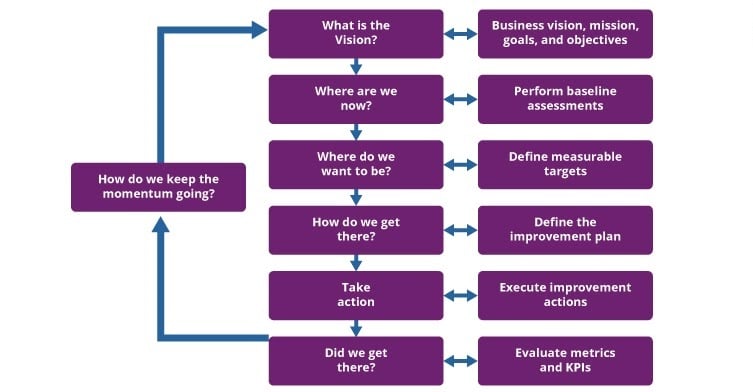Last month, we started to look at change in its different forms and briefly touched on how to...
Change management is not just managing risk
For many, a mention of change management conjures visions of endless forms, countless group calls and virtually crawling across broken glass to receive senior management approval to proceed. But change management is not simply about controlling the practical aspects of a change to minimise risk.
In reality, successful change management is (or should be) equally focussed on user interaction, ensuring the needs of the business processing teams are being met, concerns / questions are answered, those on the receiving end of the changes are trained and ultimately ensuring the success of any implementation no matter the size through the cooperation of the user base.
Change management is just a part of the ITIL framework’s continual improvement model which should be taken into consideration as a whole in order for any update / modification / remediation to be successful, the change itself is merely 1 of the 6 steps:

Continual improvement model (Ref: ITIL4® Manual from AXELOS)
During the past 20 years, this author has been involved in both small business and enterprise level deployments utilising both informal and formal ITIL framework controls. Whilst the change process itself was different, the following core principles are always valid:
- Talk to the business department(s).
- What are their main priorities?
- What tasks do they complete daily / weekly / monthly?
- What do they feel works and (more importantly) what do they find difficult to achieve?
- Get real ‘numbers’ from users themselves. Stats from a database are all well and good but only the users can tell you what really goes on.
- How long do particular tasks take?
- Do they regularly run out of resources to complete tasks?
- How often do those tasks occur?
- Which tasks create the most difficulties when not completed on time?
- Observe over a period of time to corroborate the user view.
- Discuss with the users which of their pain points are the most important to address. Do not decide for the department what will benefit them most – be collaborative and agree up front what will be addressed. The users will only buy in if they feel included.
- START FROM WHERE YOU ARE!!! (Sorry has this author mentioned this before?) Always look at the platforms / systems already in use by the department and within the business as a whole to see if the goals can be achieved with tools already available. Not only will this undoubtedly keep costs down but it will make implementation far easier not only technically but also for the users who may already be familiar with the interface.
- Demonstrate the proposed solution to the department, have them constructively comment on the initial design.
- Does it meet their needs?
- Does it create any ‘new’ problems?
- Do they agree to moving forward with the changes?
(This demonstration for acceptance may require greater negotiation skills than the superpower summits of the 1980s! If users do not see the benefit of the proposed change, do not feel involved in the design and ultimately do not accept the proposal – the change will likely fail. All that effort will be wasted. It is true that not all user ideas are good but it is the role of the architect to show the benefits and ultimately explain why. This author cannot stress enough from experience how critical this piece of the process is.)
- Implementation. So this is where the tick box exercise takes place but with the department onboard, hopefully utilising pre-existing platforms and with a demonstration of the benefits already agreed, getting that approval will be all that much easier.
- Make sure to follow up with the department after. Talk to the users once again:
- Have they noticed an improvement in their process?
- Has the issue initially targeted been resolved fully?
- Are there any other unexpected benefits?
- Are there any unexpected ramifications directly attributed to the change?
- Has anything else come up / been highlighted?
Then don’t stop. Having assisted one area of the business, either help them continue that journey addressing the next pain point or move to another area of the business. I guarantee that once one department has experienced this inclusive, direct and effective change management, other departments will be more willing to work proactively for the good of the business as a whole. Change will happen more quickly, be more successful in its implementation and will return a greater benefit.

Toby Gilbertson, Customer Services Manager. April 2021
#PacSolUK #ChangeManagement #ITIL



